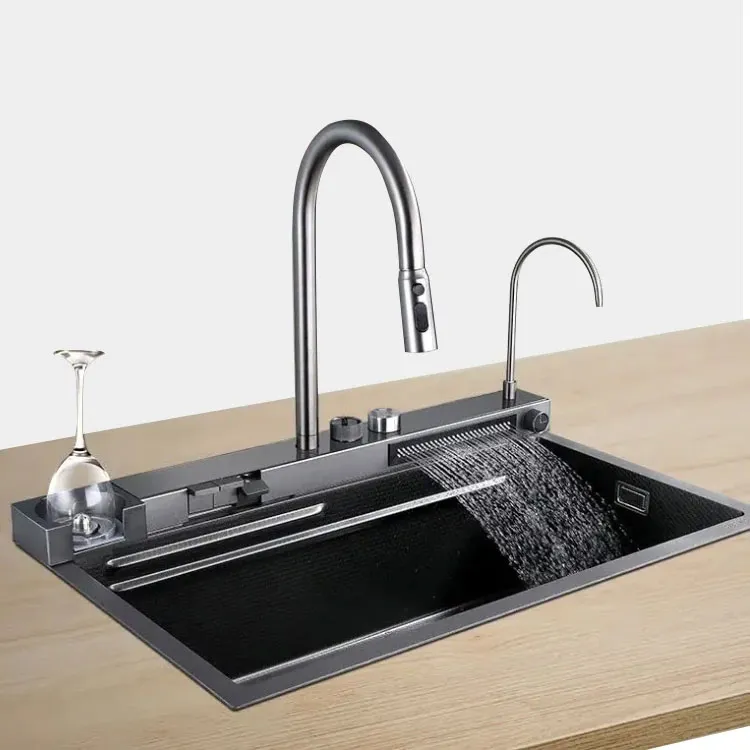A Comprehensive Guide to Kitchen Faucets: Types, Features, and Benefits
2024-10-22
The kitchen faucet is one of the most essential fixtures in any home, yet it often goes unnoticed until it needs replacing. From washing dishes to filling pots, it handles countless tasks daily. With numerous styles, technologies, and finishes available, choosing the right kitchen faucet can seem overwhelming. This blog will guide you through everything you need to know about kitchen faucets, from the types available to important features and benefits.
1. Types of Kitchen Faucets
There are several types of kitchen faucets, each designed to serve different needs and preferences. Here are some of the most common types:
a) Single-Handle Faucets
Single-handle faucets are the most common kitchen faucet type, allowing users to control both water temperature and flow with one lever. They are popular due to their simplicity, space-saving design, and ease of use.
b) Double-Handle Faucets
Double-handle faucets feature two separate handles for hot and cold water, offering more precise control over water temperature. While they require more space than single-handle models, their classic design is often favored in traditional or vintage-style kitchens.
c) Pull-Down Faucets
Pull-down faucets have a spray head that can be pulled downward, making it easier to rinse vegetables, wash dishes, or clean the sink. They are ideal for deep sinks and are known for their convenience and versatility.
d) Pull-Out Faucets
Similar to pull-down faucets, pull-out faucets have a detachable spray head, but instead of pulling downward, the head can be pulled outward. This design provides added flexibility and is especially useful for smaller sinks where there is less vertical space.
e) Touchless Faucets
Touchless faucets use motion sensors to turn the water on and off, offering hands-free operation. They are great for maintaining hygiene, especially when handling raw food, and also help conserve water by automatically shutting off when not in use.
f) Commercial-Style Faucets
Commercial-style faucets have high-arching spouts and heavy-duty sprayers, mimicking those found in professional kitchens. They are designed for larger tasks and heavy use, making them ideal for home chefs or anyone who spends significant time cooking.

2. Key Features to Consider
When selecting a kitchen faucet, it's important to consider the features that will best suit your needs. Here are some key aspects to keep in mind:
a) Sprayer Functionality
Many modern kitchen faucets come with a built-in sprayer. These sprayers can switch between different modes (e.g., stream, spray, or pause) for added convenience when washing dishes or rinsing produce.
b) Spout Height and Reach
The height and reach of the spout are important factors, especially if you frequently fill large pots or clean oversized cookware. High-arc faucets are popular for this reason, offering plenty of clearance for tall items.
c) Mounting Options
Faucets can be mounted in a variety of ways, depending on the sink or countertop configuration. Common options include:
- Deck-Mounted: Installed on the sink or countertop surface.
- Wall-Mounted: Installed on the wall, freeing up space around the sink.
- Pre-Drilled Holes: Some sinks come with pre-drilled holes, so you'll need to choose a faucet that fits the existing configuration.
d) Finishes
Kitchen faucets come in various finishes to match your kitchen's décor. Popular options include:
- Chrome: Shiny, durable, and easy to clean.
- Brushed Nickel: Sleek and less prone to showing water spots or fingerprints.
- Matte Black: Modern and stylish, adding contrast to your kitchen design.
- Stainless Steel: Durable and rust-resistant, a perfect match for many stainless steel sinks and appliances.
e) Water Efficiency
Many faucets now come with water-saving technology, such as low-flow aerators, that reduce water consumption without sacrificing performance. Look for faucets with WaterSense certification, which guarantees water efficiency.
f) Temperature Control
Advanced faucets offer features like preset temperature settings or scald protection, making it easier to adjust the water to your preferred temperature while preventing accidental burns.
3. Benefits of Upgrading Your Kitchen Faucet
Upgrading your kitchen faucet not only enhances the functionality of your kitchen but also provides other benefits, including:
a) Improved Water Efficiency
Modern faucets are designed to reduce water waste through innovative technologies like aerators that maintain strong flow while using less water. This can help you conserve water and reduce utility bills.
b) Enhanced Convenience
Features like pull-down sprayers, touchless operation, and adjustable spray patterns add convenience to daily kitchen tasks. Whether you’re rinsing dishes or washing vegetables, a high-quality faucet can make your kitchen chores more efficient.
c) Better Aesthetic Appeal
A stylish faucet can serve as the focal point of your kitchen, enhancing its overall aesthetic. Whether you prefer a minimalist modern design or a classic look, there’s a faucet to match your kitchen’s style.
d) Increased Durability
Upgrading to a premium faucet with durable materials and finishes ensures long-lasting performance. Many high-quality faucets are made from corrosion-resistant metals like stainless steel or brass, providing years of reliable use.
e) Easy Maintenance
Many modern faucets come with features that make them easier to clean and maintain, such as finishes that resist fingerprints and water spots, or removable aerators for easy cleaning. Touchless models reduce the spread of germs and grime on the faucet’s surface.
4. Installation Tips
Installing a kitchen faucet can be a DIY project if you’re comfortable working with plumbing. Here are some general tips for installation:
- Turn Off the Water Supply: Always begin by turning off the water supply to avoid flooding the sink area.
- Remove the Old Faucet: Use a basin wrench to disconnect the old faucet from the sink or countertop.
- Install the New Faucet: Follow the manufacturer’s instructions carefully, ensuring that all washers and gaskets are properly in place.
- Check for Leaks: Once the new faucet is installed, turn on the water and check for any leaks around the connections.
If you’re not comfortable installing the faucet yourself, it’s best to hire a professional plumber to ensure proper installation.
5. Popular Brands in the Market
Several trusted brands manufacture high-quality kitchen faucets, offering a range of styles and features. Some popular brands include:
- Moen: Known for innovative designs and reliable performance, Moen faucets often feature easy-to-use technology and attractive finishes.
- Delta: Delta is a leader in faucet technology, offering touchless and touch-on faucets that combine convenience with sleek designs.
- Kohler: A brand synonymous with quality, Kohler offers a wide range of kitchen faucets, including models with unique spray patterns and water-saving features.
- Grohe: Grohe faucets are known for their European craftsmanship, combining modern designs with advanced functionality.
- Pfister: Offering budget-friendly options without sacrificing quality, Pfister faucets provide a balance between affordability and durability.
Conclusion
Kitchen faucets play an essential role in your daily routine, so selecting the right one can improve both the function and style of your kitchen. Whether you're looking for a simple single-handle design, a convenient pull-down sprayer, or a touchless faucet, there are plenty of options to fit your needs. With the right kitchen faucet, you can enjoy enhanced performance, better water efficiency, and a refreshed look for your kitchen space.


